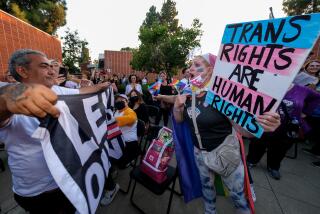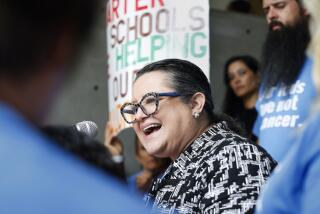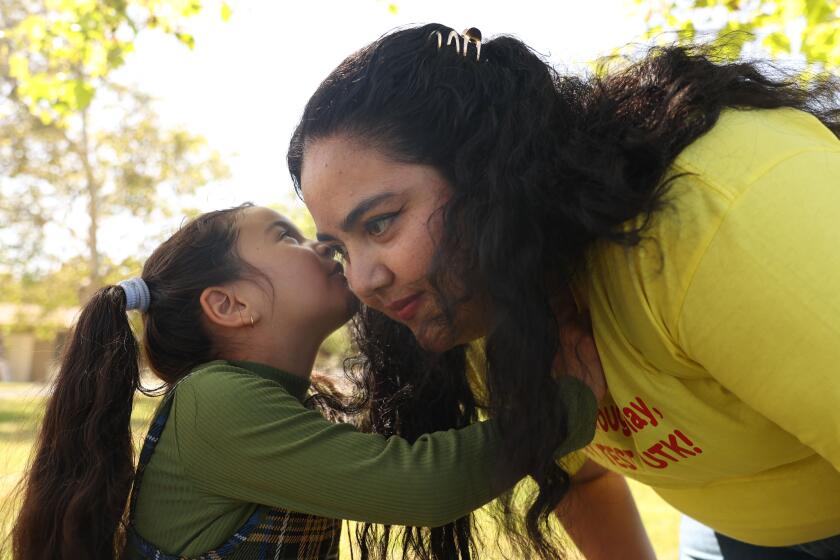L.A. School Integration Conflict Gets New Life : U.S. Justices Say NAACP Can Present Charge in Federal Court of District Bias Against Blacks
The Supreme Court cleared the way Monday for the resumption of the long legal fight over school desegregation in Los Angeles, ruling that lawyers for the NAACP can go to trial in federal court to try to prove that the city school district has unlawfully discriminated against black students since 1969.
In a brief order, the justices let stand a ruling last December by the U.S. 9th Circuit Court of Appeals in San Francisco permitting the National Assn. for the Advancement of Colored People to pursue its case in federal court, even though similar issues were litigated in state court proceedings that began in 1963 and ended in 1981.
According to school officials, the cost to the district of legal proceedings and court-ordered desegregation plans over that period exceeded $910 million.
Issue in Court
At issue in federal court will be whether the district, through its policies and actions, intentionally segregated students after May 2, 1969--the date the trial proceedings in state court ended.
If the NAACP wins in a federal trial, the court could order mandatory busing--which was ended in 1981 after state courts upheld Proposition 1, the so-called “anti-busing” initiative. That initiative, passed in 1979, bars state courts from ordering mandatory pupil reassignment and transportation, except where there is a violation of federal law.
The initiative would not bar court-ordered busing if the federal court found the district in violation of the equal-protection clause of the 14th Amendment of the U.S. Constitution.
Voluntary Busing
But city school officials Monday minimized the prospect of a resumption of any mandatory busing program, pointing out that, of the district’s 565,000 students, less than 20% are Anglos--compared to 56% in 1969. About 40,000 pupils now participate in a voluntary busing plan.
“The district is now 81% minority,” said Associate Supt. Jerry F. Halverson, counsel for the Board of Education. “I think it would be very hard to establish any kind of busing program that would be meaningful.”
However, Los Angeles city school board members said the lawsuit may have an effect on current discussions about how to solve severe overcrowding in the district. In one of several options under study to cope with an anticipated enrollment surge of 70,000 students in the next five years, school officials are re-examining the district’s integration policies to see if modifications can be made to open up more classroom seats.
The district’s lawyers expressed doubt that the NAACP could show that school policies after 1969--involving pupil assignment, boundary-drawing and similar factors--were intentionally designed to produce racial segregation. That was a period when the case was in state court and school district actions were under close court scrutiny.
“I don’t see how the district can ever be found guilty of de jure segregation (segregation sanctioned by law) in this period of time,” said G. William Shea, an attorney for the district. “Everything that was done by the district then was subject to court review.”
Nonetheless, lawyers for the six branches of the NAACP involved in the action predicted that they would prevail in a federal court trial. “I am confident we’ll win,” said Grover G. Hankins, an NAACP attorney in New York City.
Some Busing Sought
Joseph Duff, local counsel for the NAACP, said the group will seek “some busing of students,” although he declined to say how extensive the busing should be. Hankins did acknowledge that the group might seek a desegregation plan that would include other school districts besides Los Angeles.
Duff brushed aside the district’s argument that busing to achieve integration would be meaningless in a predominantly minority school district. “There is no question that it works. . . . It does desegregate schools,” he said.
Also, because state authorities have been included as defendants in the case along with the district, it is possible that the NAACP would seek substantial financial aid from the state to help support a desegregation program for Los Angeles. The case is expected to go to trial before U.S. District Judge A. Wallace Tashima by next spring or summer.
In its appeal of the federal appellate court ruling (Los Angeles Unified School District vs. Los Angeles NAACP, 85-27), school authorities argued that the case should be limited to actions by the district after Sept. 10, 1981, when the state court action became final.
Under the appellate decision, the NAACP would be allowed to call the same witnesses and offer the same evidence presented in state court proceedings, the district noted. During those proceedings, in the case of Crawford vs. Board of Education, 91 witnesses were called, more than 26,000 pages of testimony were taken and 17 applications were filed for state appellate court review.
Legal Gamesmanship
“The decision (of the federal appeals court) rewards a form of legal gamesmanship that should be vigorously discouraged,” the district said in its petition to the Supreme Court.
The NAACP also appealed the federal appeals ruling to the justices (Los Angeles NAACP vs. Los Angeles Unified School District, 85-213), arguing that it should be allowed to present evidence of discrimination by the district before May, 1969.
The lawyers for the group said that because of the “exceptional circumstances” of the case, the NAACP should not be precluded from widening the case to include actions and policies by the district long before that appeals court’s cutoff date.
Board Reaction
Reactions of Los Angeles school board members to the revival of the desegregation controversy ranged from sadness and disappointment to sympathy for the plaintiffs.
“I’m very disappointed we have to go through this court case again,” said Roberta Weintraub, the conservative East San Fernando Valley board member who was elected on an anti-busing platform in 1979. “We did it once. It’s enough.”
However, Board President Rita Walters, who represents the South-Central and Southwest portions of the district, said she was “very sympathetic” to the NAACP’s charges.
“As an individual who was very much involved in the move to desegregate (in the 1960s and 1970s), I feel there is ample evidence that the district was less than sensitive to the problem, she said.
Both Weintraub and board member David Armor, who represents the district in the West San Fernando Valley, said the lawsuit will have a major effect on a proposal now before the board that addresses solutions to severe crowding in district schools.
The board is studying a proposal presented by Supt. Harry Handler earlier this month that calls for placing the entire district on year-round operation in order to make room for the projected enrollment increase.
One part of the 10-point plan calls for changing the definition of an integrated school from one that is 60% minority and 40% white to 70% minority and 30% white. Under the current guidelines, Latino students from areas near downtown are bused past “segregated” inner-city schools to distant Valley schools that have at least 40% white children.
District officials also are considering increasing class size from 27 to 29 in certain inner-city classrooms.
According to district staff calculations, the two proposed measures would open up an additional 33,000 seats.
“Personally, I think any attempt to change those definitions while we are in court would be extremely risky,” Armor said. “I don’t know what our legal staff will say but . . . I think it would be a terrible mistake for the board to do anything that would differentially impact on minority schools. We could open ourselves up for (a charge of) an act of discrimination.”
Philip Hager reported from Washington and Elaine Woo from Los Angeles.
More to Read
Start your day right
Sign up for Essential California for news, features and recommendations from the L.A. Times and beyond in your inbox six days a week.
You may occasionally receive promotional content from the Los Angeles Times.







